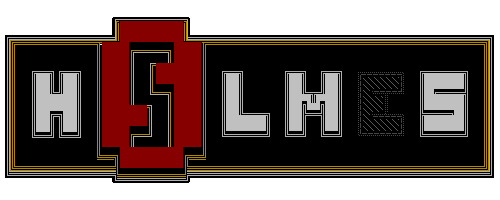Text to Unicode code points breakdown
Project description
CLI UTF-8 decomposer for text analysis capable of displaying Unicode code point names and categories, along with ASCII control characters, UTF-16 surrogate pair pieces, invalid UTF-8 sequences parts as separate bytes, etc.
Motivation
A necessity for a tool that can quickly identify otherwise indistinguishable Unicode code points.
Installation
With pipx (recommended)
pipx install holms
From git repository
curl -sS https://github.com/es7s/holms/blob/master/install.sh | sh
Basic usage
Usage: holms run [OPTIONS] [INPUT]
Read data from INPUT file, find all valid UTF-8 byte sequences, decode them and display as
separate Unicode code points. Use '-' as INPUT to read from stdin instead.
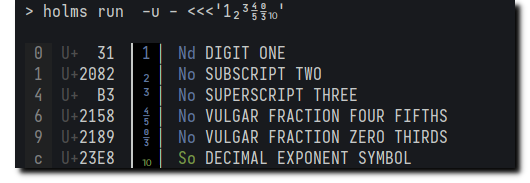
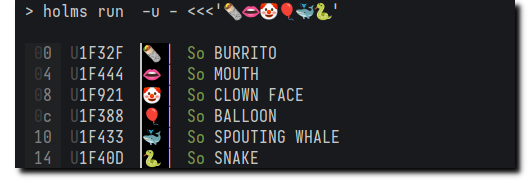
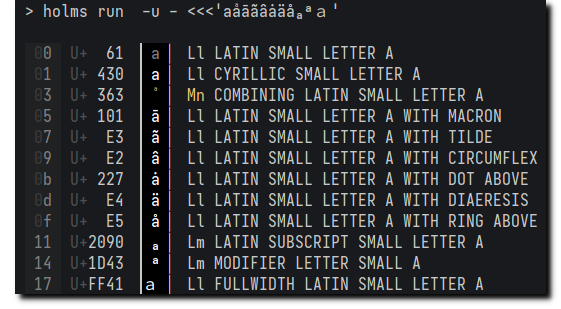
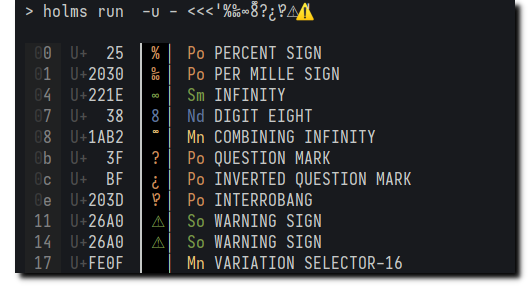
Plain text output
> holms run -u - <<<'1₂³⅘↉⏨'
0 U+ 31 ▕ 1 ▏ Nd DIGIT ONE
1 U+2082 ▕ ₂ ▏ No SUBSCRIPT TWO
4 U+ B3 ▕ ³ ▏ No SUPERSCRIPT THREE
6 U+2158 ▕ ⅘ ▏ No VULGAR FRACTION FOUR FIFTHS
9 U+2189 ▕ ↉ ▏ No VULGAR FRACTION ZERO THIRDS
c U+23E8 ▕ ⏨ ▏ So DECIMAL EXPONENT SYMBOL
> holms run -u - <<<'🌯👄🤡🎈🐳🐍'
00 U1F32F ▕🌯 ▏ So BURRITO
04 U1F444 ▕👄 ▏ So MOUTH
08 U1F921 ▕🤡 ▏ So CLOWN FACE
0c U1F388 ▕🎈 ▏ So BALLOON
10 U1F433 ▕🐳 ▏ So SPOUTING WHALE
14 U1F40D ▕🐍 ▏ So SNAKE
> holms run -u - <<<'aаͣāãâȧäåₐᵃa'
00 U+ 61 ▕ a ▏ Ll LATIN SMALL LETTER A
01 U+ 430 ▕ а ▏ Ll CYRILLIC SMALL LETTER A
03 U+ 363 ▕ ͣ ▏ Mn COMBINING LATIN SMALL LETTER A
05 U+ 101 ▕ ā ▏ Ll LATIN SMALL LETTER A WITH MACRON
07 U+ E3 ▕ ã ▏ Ll LATIN SMALL LETTER A WITH TILDE
09 U+ E2 ▕ â ▏ Ll LATIN SMALL LETTER A WITH CIRCUMFLEX
0b U+ 227 ▕ ȧ ▏ Ll LATIN SMALL LETTER A WITH DOT ABOVE
0d U+ E4 ▕ ä ▏ Ll LATIN SMALL LETTER A WITH DIAERESIS
0f U+ E5 ▕ å ▏ Ll LATIN SMALL LETTER A WITH RING ABOVE
11 U+2090 ▕ ₐ ▏ Lm LATIN SUBSCRIPT SMALL LETTER A
14 U+1D43 ▕ ᵃ ▏ Lm MODIFIER LETTER SMALL A
17 U+FF41 ▕a ▏ Ll FULLWIDTH LATIN SMALL LETTER A
> holms run -u - <<<'%‰∞8᪲?¿‽⚠⚠️'
00 U+ 25 ▕ % ▏ Po PERCENT SIGN
01 U+2030 ▕ ‰ ▏ Po PER MILLE SIGN
04 U+221E ▕ ∞ ▏ Sm INFINITY
07 U+ 38 ▕ 8 ▏ Nd DIGIT EIGHT
08 U+1AB2 ▕ ᪲ ▏ Mn COMBINING INFINITY
0b U+ 3F ▕ ? ▏ Po QUESTION MARK
0c U+ BF ▕ ¿ ▏ Po INVERTED QUESTION MARK
0e U+203D ▕ ‽ ▏ Po INTERROBANG
11 U+26A0 ▕ ⚠ ▏ So WARNING SIGN
14 U+26A0 ▕ ⚠ ▏ So WARNING SIGN
17 U+FE0F ▕ ️ ▏ Mn VARIATION SELECTOR-16
Buffering
The application works in two modes: buffered (the default if INPUT is a
file) and unbuffered (default when reading from stdin). Options -b/-u
explicitly override output mode regardless of the default setting.
In buffered mode the result begins to appear only after EOF is encountered (i.e., the WHOLE file has been read to the buffer). This is suitable for short and predictable inputs and produces the most compact output with fixed column sizes.
The unbuffered mode comes in handy when input is an endless piped stream: the results will be displayed in real time, as soon as the type of each byte sequence is determined, but the output column widths are not fixed and can vary as the process goes further.
Despite the name, the app actually uses tiny (4 bytes) input buffer, but it's the only way to handle UTF-8 stream and distinguish valid sequences from broken ones; in truly unbuffered mode the output would consist of ASCII-7 characters (
0x00-0x7F) and unrecognized binary data (0x80-0xFF) only, which is not something the application was made for.
Configuration / Advanced usage
Options:
-b, --buffered / -u, --unbuffered
Explicitly set to wait for EOF before processing the
output (buffered), or to stream the results in
parallel with reading, as soon as possible
(unbuffered). See BUFFERING section above for the
details.
-m, --merge Replace all sequences of repeating characters with one
of each, together with initial length of the sequence.
-g, --group Group the input by code points (=count unique), sort
descending and display counts instead of normal
output. Implies '--merge' and forces buffered ('-b')
mode. Specifying the option twice ('-gg') results in
grouping by code point category instead, while doing
it thrice ('-ggg') makes the app group the input by
super categories.
-f, --format Comma-separated list of columns to show (order is
preserved). Run 'holms format' to see the details.
-n, --names Display names instead of abbreviations. Affects `cat`
and `block` columns, but only if column in question is
already present on the screen. Note that these columns
can still display only the beginning of the attribute,
unless '-r' is provided.
-a, --all Display ALL columns.
-r, --rigid By default some columns can be compressed beyond the
nominal width, if all current values fit and there is
still space left. This option disables column
shrinking (but they still will be expanded when
needed).
--decimal Use decimal byte offsets instead of hexadecimal.
--oneline Discard all newline characters (0x0a LINE FEED) from
the input.
--no-table Do not format results as a table, just apply the
colors to characters (equivalent to '-f char', implies
'-b'). Compatible with '-merge', '--format' and even '
--group'.
--no-override Do not replace control/whitespace code point markers
with distinguishable characters ('▯' to '↵', '␣' etc).
Run 'holms legend' to see the details.
-?, --help Show this message and exit.
Examples
Output column selection
Option -f/--filter can be used to specify what columns to display. As an
alternative, there is an -a/--all option that enables displaying of all
currently available columns.
Column availability depending on operating mode
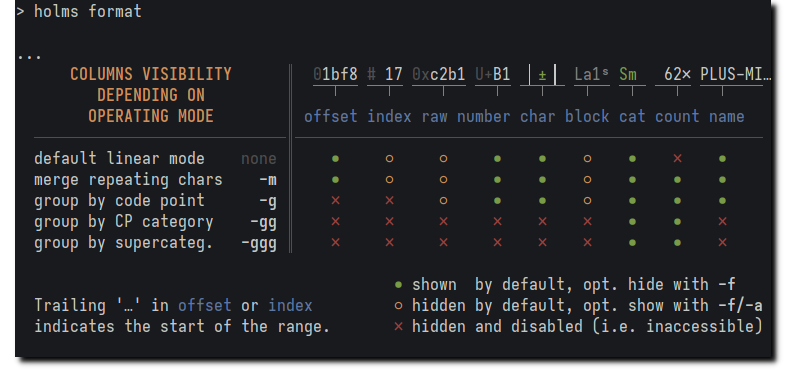
Also -m/--merge option is demonstrated, which tells the app to collapse
repetitive characters into one line of the output while counting them:
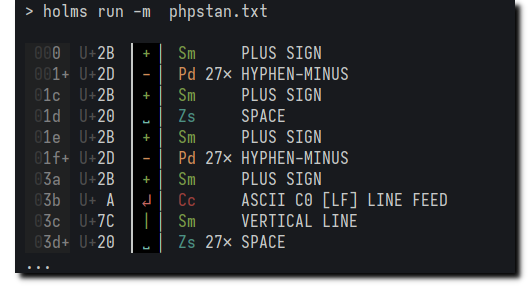
Plain text output
> holms run -m phpstan.txt
000 U+2B ▕ + ▏ Sm PLUS SIGN
001+ U+2D ▕ - ▏ Pd 27× HYPHEN-MINUS
01c U+2B ▕ + ▏ Sm PLUS SIGN
01d U+20 ▕ ␣ ▏ Zs SPACE
01e U+2B ▕ + ▏ Sm PLUS SIGN
01f+ U+2D ▕ - ▏ Pd 27× HYPHEN-MINUS
03a U+2B ▕ + ▏ Sm PLUS SIGN
03b U+ A ▕ ↵ ▏ Cc ASCII C0 [LF] LINE FEED
03c U+7C ▕ | ▏ Sm VERTICAL LINE
03d+ U+20 ▕ ␣ ▏ Zs 27× SPACE
...
Reading from pipeline
There is an official Unicode Consortium data file included in the repository for
test purposes, named confusables.txt. In the next
example we extract line #3620 using sed, delete all TAB (0x08) characters
and feed the result to the application. The result demonstrates various Unicode
dot/bullet code points:
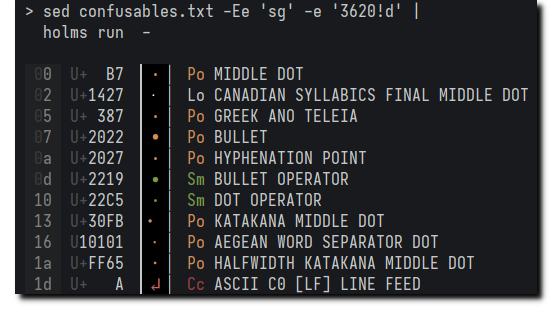
Plain text output
> sed confusables.txt -Ee 'sg' -e '3620!d' |
holms run -
00 U+ B7 ▕ · ▏ Po MIDDLE DOT
02 U+1427 ▕ ᐧ ▏ Lo CANADIAN SYLLABICS FINAL MIDDLE DOT
05 U+ 387 ▕ · ▏ Po GREEK ANO TELEIA
07 U+2022 ▕ • ▏ Po BULLET
0a U+2027 ▕ ‧ ▏ Po HYPHENATION POINT
0d U+2219 ▕ ∙ ▏ Sm BULLET OPERATOR
10 U+22C5 ▕ ⋅ ▏ Sm DOT OPERATOR
13 U+30FB ▕・ ▏ Po KATAKANA MIDDLE DOT
16 U10101 ▕ 𐄁 ▏ Po AEGEAN WORD SEPARATOR DOT
1a U+FF65 ▕ ・ ▏ Po HALFWIDTH KATAKANA MIDDLE DOT
1d U+ A ▕ ↵ ▏ Cc ASCII C0 [LF] LINE FEED
Code points / categories statistics
-g/--group option can be used to count unique code points, and to compute
the occurrence rate of each one:
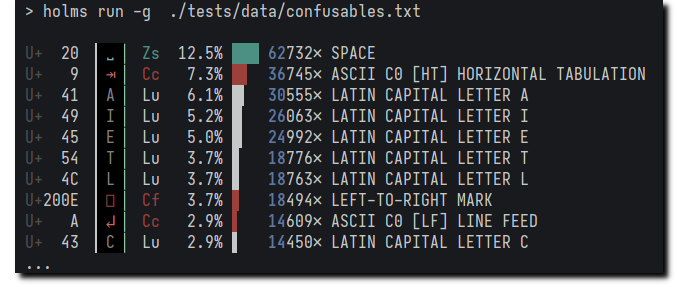
Plain text output
> holms run -g ./tests/data/confusables.txt
U+ 20 ▕ ␣ ▏ Zs 12.5% ███ 62732× SPACE
U+ 9 ▕ ⇥ ▏ Cc 7.3% █▊ 36745× ASCII C0 [HT] HORIZONTAL TABULATION
U+ 41 ▕ A ▏ Lu 6.1% █▍ 30555× LATIN CAPITAL LETTER A
U+ 49 ▕ I ▏ Lu 5.2% █▏ 26063× LATIN CAPITAL LETTER I
U+ 45 ▕ E ▏ Lu 5.0% █▏ 24992× LATIN CAPITAL LETTER E
U+ 54 ▕ T ▏ Lu 3.7% ▉ 18776× LATIN CAPITAL LETTER T
U+ 4C ▕ L ▏ Lu 3.7% ▉ 18763× LATIN CAPITAL LETTER L
U+200E ▕ ▯ ▏ Cf 3.7% ▉ 18494× LEFT-TO-RIGHT MARK
U+ A ▕ ↵ ▏ Cc 2.9% ▋ 14609× ASCII C0 [LF] LINE FEED
U+ 43 ▕ C ▏ Lu 2.9% ▋ 14450× LATIN CAPITAL LETTER C
...
When used twice (-gg) or thrice (-ggg), the application groups the input by
code point category or code point super category, respectively, which can be used
e.g. for frequency domain analysis:
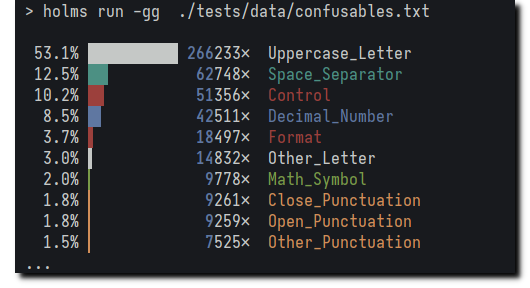

Plain text output
> holms run -gg ./tests/data/confusables.txt
53.1% ██████████ 266233× Uppercase_Letter
12.5% ██▎ 62748× Space_Separator
10.2% █▉ 51356× Control
8.5% █▌ 42511× Decimal_Number
3.7% ▋ 18497× Format
3.0% ▌ 14832× Other_Letter
2.0% ▎ 9778× Math_Symbol
1.8% ▎ 9261× Close_Punctuation
1.8% ▎ 9259× Open_Punctuation
1.5% ▎ 7525× Other_Punctuation
...
> holms run -ggg ./tests/data/confusables.txt
56.7% ██████████ 284074× Letter
13.9% ██▍ 69853× Other(C)
12.5% ██▏ 62750× Separator(Z)
8.5% █▌ 42796× Number
5.9% █ 29571× Punctuation
2.2% ▍ 11072× Symbol
0.2% ▏ 965× Mark
In-place type highlighting
When --format is specified exactly as a single char column: --format=char,
the application omits all the columns and prints the original file contents,
while highligting each character with a color that indicates its' Unicode
category.
Note that ASCII control codes, as well as Unicode ones, are kept untouched and invisible.
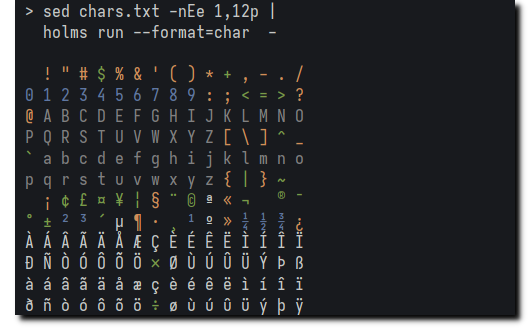
Plain text output
> sed chars.txt -nEe 1,12p |
holms run --format=char -
! " # $ % & ' ( ) * + , - . /
0 1 2 3 4 5 6 7 8 9 : ; < = > ?
@ A B C D E F G H I J K L M N O
P Q R S T U V W X Y Z [ \ ] ^ _
` a b c d e f g h i j k l m n o
p q r s t u v w x y z { | } ~
¡ ¢ £ ¤ ¥ ¦ § ¨ © ª « ¬ ® ¯
° ± ² ³ ´ µ ¶ · ¸ ¹ º » ¼ ½ ¾ ¿
À Á Â Ã Ä Å Æ Ç È É Ê Ë Ì Í Î Ï
Ð Ñ Ò Ó Ô Õ Ö × Ø Ù Ú Û Ü Ý Þ ß
à á â ã ä å æ ç è é ê ë ì í î ï
ð ñ ò ó ô õ ö ÷ ø ù ú û ü ý þ ÿ
ASCII latin letters (A-Za-z) are colored in 50% gray color instead of regular
white on purpose — this can be extremely helpful when the task is to find
non-ASCII character(s) in an massive text of plain ASCII ones, or vice versa.
Below is a real example of broken characters which are the result of two operations being applied in the wrong order: UTF-8 decoding and URL %-based unescaping. This error is different from incorrect codepage selection errors, which mess up the whole text or a part of it; all byte sequences are valid UTF-8 encoded code points, but the result differs from the origin and is completely unreadable nevertheless.
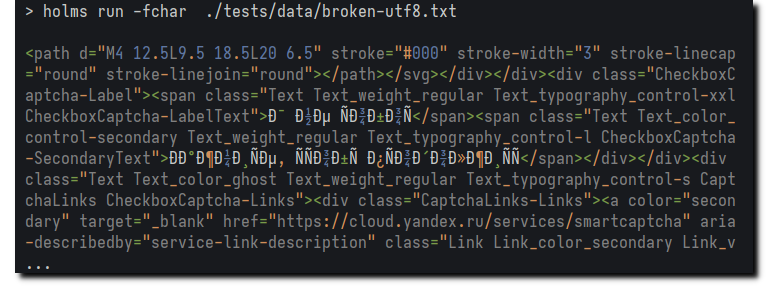
ASCII C0 / C1 details
While developing the application I encountered strange (as it seemed to be at the beginning) behaviour of Python interpreter, which encoded C1 control bytes as two bytes of UTF-8, while C0 control bytes were displayed as sole bytes, like it would have been encoded in a plain ASCII. Then there was a bit of researching done.
According to ISO/IEC 6429 (ECMA-48),
there are two types of ASCII control codes (to be precise, much more, but for
our purposes it's mostly irrelevant) — C0 and C1. The first one includes ASCII
code points 0x00-0x1F and 0x7F (some authors also include a regular space
character 0x20 in this list), and the characteristic property of this type is
that all C0 code points are encoded in UTF-8 exactly the same as they do in
7-bit US-ASCII (ISO/IEC 646). This
helps to disambiguate exactly what type of encoding is used even for broken byte
sequences, considering the task is to tell if a byte represents sole code point
or is actually a part of multibyte UTF-8 sequence.
However, C1 control codes are represented by 0x80-0x9F bytes, which also are
valid bytes for multibyte UTF-8 sequences. In order to distinguish the first
type from the second UTF-8 encodes them as two-byte sequences instead (0x80 →
0xC280, etc.); also this applies not only to control codes, but to all other
ISO/IEC 8859 code points starting
from 0x80.
With this in mind, let's see how the application reflects these differences. First command produces several 8-bit ASCII C1 control codes, which are classified as raw binary/non-UTF-8 data, while the second command's output consists of the very same code points but being encoded in UTF-8 (thanks to Python's full transparent Unicode support, we don't even need to bother much about the encodings and such):

Plain text output
> printf "\x80\x90\x9f" && python3 -c 'print("\x80\x90\x9f", end="")' |
holms run --names --decimal --all -
⏨0 #0 0x 80 -- ▕ ▯ ▏ NON UTF-8 BYTE 0x80 -- Binary
⏨1 #1 0x 90 -- ▕ ▯ ▏ NON UTF-8 BYTE 0x90 -- Binary
⏨2 #2 0x 9f -- ▕ ▯ ▏ NON UTF-8 BYTE 0x9F -- Binary
⏨3 #3 0x c2 80 U+80 ▕ ▯ ▏ ASCII C1 [PC] PADDING CHARACTER Latin-1 Supplem‥ Control
⏨5 #4 0x c2 90 U+90 ▕ ▯ ▏ ASCII C1 [DCS] DEVICE CONTROL STRING Latin-1 Supplem‥ Control
⏨7 #5 0x c2 9f U+9F ▕ ▯ ▏ ASCII C1 [APC] APPLICATION PROGRAM COMMAND Latin-1 Supplem‥ Control
Legend
The image below illustrates the color scheme developed for the app specifically, to simplify distinguishing code points of one category from others.
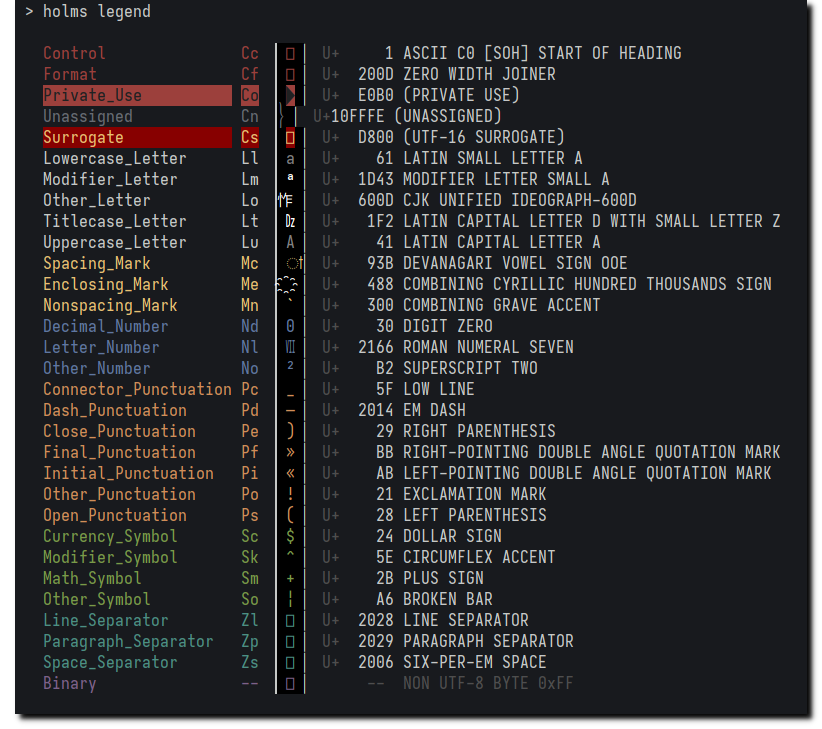
Most frequently encountering control codes also have a unique character replacements, which allows to recognize them without reading the label or memorizing code point identifiers:

Unicode Blocks

Changelog
Project details
Release history Release notifications | RSS feed
Download files
Download the file for your platform. If you're not sure which to choose, learn more about installing packages.
Source Distribution
Built Distribution
File details
Details for the file holms-1.5.0.tar.gz.
File metadata
- Download URL: holms-1.5.0.tar.gz
- Upload date:
- Size: 195.2 kB
- Tags: Source
- Uploaded using Trusted Publishing? No
- Uploaded via: python-httpx/0.24.1
File hashes
| Algorithm | Hash digest | |
|---|---|---|
| SHA256 | ac6e475fbeeff65e5c978a594ba8ab7490db9d30016cf13bc38621deae20da5f |
|
| MD5 | 56d8c989feb4a3e4d3d5f3ea2474dcd2 |
|
| BLAKE2b-256 | b3c18971ff69214db8cba64a93dd9e5c1edd7d8dc89767b721c65c94d7764813 |
File details
Details for the file holms-1.5.0-py3-none-any.whl.
File metadata
- Download URL: holms-1.5.0-py3-none-any.whl
- Upload date:
- Size: 45.5 kB
- Tags: Python 3
- Uploaded using Trusted Publishing? No
- Uploaded via: python-httpx/0.24.1
File hashes
| Algorithm | Hash digest | |
|---|---|---|
| SHA256 | ab660671a3186d17499c07f82973a96f1093aeb53cd57d368fb106a5c7704c2c |
|
| MD5 | b3c8b107f06c608e426beee90ac3db2e |
|
| BLAKE2b-256 | 6ddcc056ac8c7fa6f3e1575921513657dd3cc60865ec7ba58433b36f24b28ca6 |


